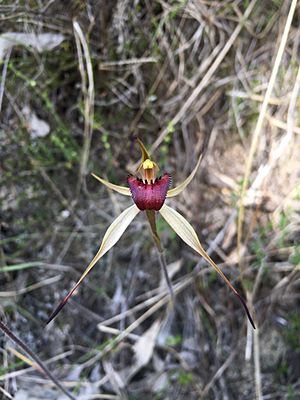Mountain spider orchid facts for kids
Quick facts for kids Mountain spider orchid |
|
|---|---|
 |
|
| Caladenia montana growing in Namadgi National Park | |
| Scientific classification | |
| Synonyms | |
|
The mountain spider orchid (scientific name: Caladenia montana) is a special type of orchid that grows only in certain parts of Australia. You can find it in New South Wales, Victoria, and the Australian Capital Territory. This ground orchid has a single leaf and a beautiful greenish-cream or cream-colored flower. Sometimes, its flower even has reddish marks! It likes to grow in high mountain forests.
Contents
What Does the Mountain Spider Orchid Look Like?
The mountain spider orchid is a plant that grows from an underground tuber (like a small potato). It's a perennial plant, meaning it lives for more than two years. It's also deciduous, so its leaves might fall off at certain times.
This orchid has one leaf, which is about 8 to 20 centimeters (3 to 8 inches) long and 8 to 12 millimeters (about half an inch) wide. A single flower grows on a stem that stands 10 to 25 centimeters (4 to 10 inches) tall. The flower itself is about 4 to 6 centimeters (1.5 to 2.5 inches) wide.
Flower Parts
The flower has special parts called sepals and petals. The sepals have dark red or brownish tips that look like clubs. These tips are about 8 to 15 millimeters (0.3 to 0.6 inches) long.
- The top sepal is about 3 to 4 centimeters (1.2 to 1.6 inches) long and curves forward.
- The side sepals are also 3 to 4 centimeters long, but they point downwards.
- The petals are about 2.5 to 3.3 centimeters (1 to 1.3 inches) long and are arranged like the side sepals.
The labellum (the orchid's special lip petal) is mostly dark red. It's about 1 to 1.2 centimeters (0.4 to 0.5 inches) long. Its sides turn up, and the tip curls under. The labellum has small, dark red "teeth" along its edges and rows of bumps called calli down its middle. This orchid usually blooms from November to January.
How the Mountain Spider Orchid Got Its Name
The scientific name Caladenia montana was first officially described in 1991 by a scientist named Geoffrey Carr. The word montana comes from Latin, and it means "of mountains." This makes sense because the orchid grows in mountain areas!
Where the Mountain Spider Orchid Lives
You can find the mountain spider orchid growing in mountain forests. It lives at heights of about 700 to 1000 meters (2,300 to 3,300 feet) above sea level. It grows in the southern tablelands of New South Wales, the Australian Capital Territory, and the high country of Victoria.
Protecting the Mountain Spider Orchid
The mountain spider orchid is considered "vulnerable." This means it's at risk of disappearing if we don't protect it. In New South Wales, there's a law called the Threatened Species Conservation Act 1995 that helps protect plants like this orchid.
The main dangers to the mountain spider orchid are:
- Weed invasion: Other plants (weeds) can grow too much and take over the orchid's space.
- Trampling and grazing: Animals like cattle, wild horses, and pigs can walk on the orchids or eat them.

